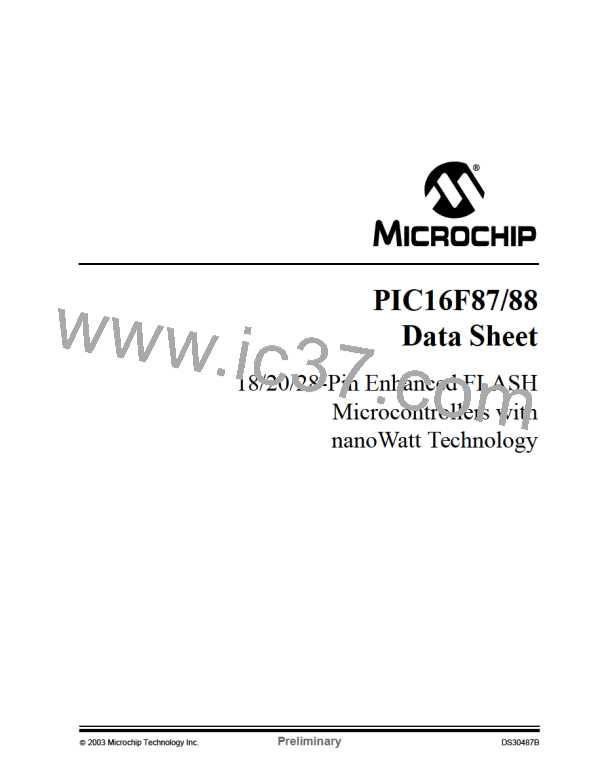PIC16F87/88
FIGURE 4-2:
CERAMIC RESONATOR
4.3
External Clock Input
OPERATION (HS OR XT
OSC CONFIGURATION)
The ECIO Oscillator mode requires an external clock
source to be connected to the OSC1 pin. There is no
oscillator start-up time required after a Power-on
Reset, or after an exit from SLEEP mode.
OSC1
PIC16F87/88
C1(1)
In the ECIO Oscillator mode, the OSC2 pin becomes
an additional general purpose I/O pin. The I/O pin
becomes bit 6 of PORTA (RA6). Figure 4-3 shows the
pin connections for the ECIO Oscillator mode.
RES
(3)
RF
SLEEP
OSC2
(2)
RS
C2(1)
To Internal
Logic
FIGURE 4-3:
EXTERNAL CLOCK INPUT
OPERATION
Note 1: See Table 4-2 for typical values of C1 and
(ECIO CONFIGURATION)
C2.
2: A series resistor (RS) may be required.
OSC1/CLKI
PIC16F87/88
I/O (OSC2)
Clock from
Ext. System
3: RF varies with the resonator chosen
(typically between 2 MΩ to 10 MΩ).
RA6
TABLE 4-2:
CERAMIC RESONATORS
(FOR DESIGN GUIDANCE
ONLY)
Typical Capacitor Values Used:
Mode
Freq
OSC1
OSC2
XT
455 kHz
2.0 MHz
4.0 MHz
56 pF
47 pF
33 pF
56 pF
47 pF
33 pF
HS
8.0 MHz
16.0 MHz
27 pF
22 pF
27 pF
22 pF
Capacitor values are for design guidance only.
These capacitors were tested with the resonators
listed below for basic start-up and operation. These
values were not optimized.
Different capacitor values may be required to produce
acceptable oscillator operation. The user should test
the performance of the oscillator over the expected
VDD and temperature range for the application.
See the notes following this table for additional
information.
Note:
When using resonators with frequencies
above 3.5 MHz, the use of HS mode,
rather than XT mode, is recommended.
HS mode may be used at any VDD for
which the controller is rated. If HS is
selected, it is possible that the gain of the
oscillator will overdrive the resonator.
Therefore, a series resistor should be
placed between the OSC2 pin and the
resonator. As a good starting point, the
recommended value of RS is 330Ω.
DS30487B-page 36
Preliminary
2003 Microchip Technology Inc.

 MICROCHIP [ MICROCHIP ]
MICROCHIP [ MICROCHIP ]